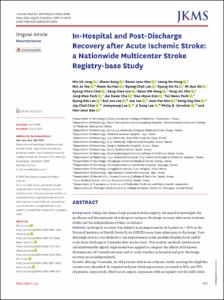In-Hospital and Post-Discharge Recovery After Acute Ischemic Stroke: A Nationwide Multicenter Stroke Registry-base Study
- Keimyung Author(s)
- Hong, Jeong Ho
- Department
- Dept. of Neurology (신경과학)
- Journal Title
- Journal of Korean medical science
- Issued Date
- 2019
- Volume
- 34
- Issue
- 36
- Abstract
- Background:
Using data from a large national stroke registry, we aimed to investigate the incidence and determinants of in-hospital and post-discharge recovery after acute ischemic stroke and the independence of their occurrence.
Methods:
In-hospital recovery was defined as an improvement of 4 points or > 40% in the National Institutes of Health Stroke Scale (NIHSS) score from admission to discharge. Post-discharge recovery was defined as any improvement in the modified Rankin Scale (mRS) score from discharge to 3 months after stroke onset. Two analytic methods (multivariate and multivariable logistic regression) were applied to compare the effects of 18 known determinants of 3-month outcome and to verify whether in-hospital and post-discharge recovery occur independently.
Results:
During 54 months, 11,088 patients with acute ischemic stroke meeting the eligibility criteria were identified. In-hospital and post-discharge recovery occurred in 36% and 33% of patients, respectively. Multivariate logistic regression with an equality test for odds ratios showed that 7 determinants (age, onset-to-admission time, NIHSS score at admission, blood glucose at admission, systolic blood pressure, smoking, recanalization therapy) had a differential effect on in-hospital and post-discharge recovery in the way of the opposite direction or of the same direction with different degree (all P values < 0.05). Both in-hospital and post-discharge recovery occurred in 12% of the study population and neither of them in 43%. The incidence of post-discharge recovery in those with in-hospital recovery was similar to that in those without (33.8% vs. 32.7%, respectively), but multivariable analysis showed that these 2 types of recovery occurred independently.
Conclusion:
Our findings suggest that, in patients with acute ischemic stroke, in-hospital and post-discharge recovery may occur independently and largely in response to different factors.
- Keimyung Author(s)(Kor)
- 홍정호
- Publisher
- School of Medicine (의과대학)
- Citation
- Min Uk Jang et al. (2019). In-Hospital and Post-Discharge Recovery After Acute Ischemic Stroke: A Nationwide Multicenter Stroke Registry-base Study. Journal of Korean medical science, 34(36), e240–e240. doi: 10.3346/jkms.2019.34.e240
- Type
- Article
- ISSN
- 1598-6357
- Source
- https://jkms.org/DOIx.php?id=10.3346/jkms.2019.34.e240
- Appears in Collections:
- 1. School of Medicine (의과대학) > Dept. of Neurology (신경과학)
- 파일 목록
-
-
Download
 oak-2019-0347.pdf
기타 데이터 / 1.9 MB / Adobe PDF
oak-2019-0347.pdf
기타 데이터 / 1.9 MB / Adobe PDF
-
Items in Repository are protected by copyright, with all rights reserved, unless otherwise indicated.